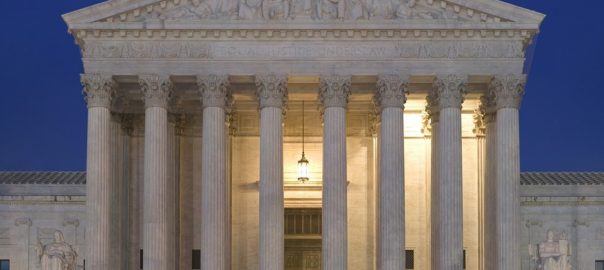Johnson v. United States
13-7120
Supreme Court of the United States
Decided: June 26, 2015
ISSUE
Whether an increased sentence
under the Armed Career Criminal Act’s (ACCA) residual clause violates the
Constitution’s guarantee of due process where the language used in the statute
is ambiguous and leaves too much room for interpretation.
HOLDING
The Court held that the imposition of an increased sentence under the ACCA’s residual clause
violates due process because the language used to define a “violent felony” is
too vague to be properly enforced. The Act states, “…or otherwise involves
conduct that presents a serious potential risk of physical injury to another.”
§ 924(e)(2)(B). The statute’s ambiguity
brings into question how risk can be estimated and how much risk is takes for a
crime to qualify as a violent felony.
FACTS OF THE CASE
Samuel Johnson has a long history of
criminal behavior. Before pleading guilty to being a felon in possession of a firearm, the FBI began to monitor Johnson’s
involvement in a white-supremacist organization that they believed was planning
to commit acts of terrorism. During the
investigation, Johnson revealed his plans of attack to an undercover agent and disclosed that he
manufactured explosives which he planned to use in the attacks. He proceeded to showing the agents his AK-47
rifle, serval semiautomatic firearms and over 1,000 rounds of
ammunition.
After Johnson was eventually
arrested, the Government attempted to enhance petitioner Johnson’s
sentencing under the ACCA. Under the ACCA, an increased prison sentence is
given to a defendant with three or more prior convictions for a “violent felony.”
The District Court determined that three of Johnson’s prior offenses, including
the unlawful possession of a
short-barreled shotgun,
qualified as violent felonies under the ACCA and subsequently sentenced him to a
15-years in prison. The Circuit Court affirmed and the Supreme Court later granted certiorari in order
to determine whether Minnesota’s offense of unlawful possession of a
short-barreled shotgun
ranks as a violent felony under the residual clause of the ACCA.
COURT’S ANALYSIS
The Court held that the imposition of an increased sentence under the ACCA’s
residual clause
violates due process because the language used to define a “violent felony” is
too vague to be properly enforced. The
Fifth Amendment states, “no person shall . . . be deprived of life, liberty, or
property, without due process of law.”
In this case the Supreme Court found that the Government is in
violation of the Due Process Clause of the Fifth Amendment under a criminal law
so vague that it does not give “ordinary people fair notice of the conduct it
punishes, or so standardless that it invites arbitrary enforcement.” Kolender
v. Lawson, 461 U.S. 352, 357 – 358, 103 S.Ct 1855, 75 L.Ed.2d 903
(1983). The prohibition of vagueness in
criminal statutes is a principle applied not only to statutes defining crime
but also to statutes determining sentencing; it is a “well-recognized requirement, consonant alike with
ordinary notions of fair play and the settled rules of law…” Connally v.
General Costr. Co., 269 U.S. 385, 391, 46 S.Ct. 126, 70 L.Ed. 322 (926).
The residual clause says that any prior conviction can count
as a violent felony, even if it does not require violence or attempted violence
as an element, if the offense nevertheless “involves conduct that presents a
serious potential risk of physical injury to another.” Thus, non-violent
offenses that still have a “serious potential risk” of violence can
count. The problem with the clause is that federal judges cannot agree as
to what non-violent offenses should “categorically” fit this general
definition.
In Taylor v. U.S., it was
held that the ACCA required courts to use a categorical approach when deciding whether an offense
“is burglary, arson, or extortion, involves use of explosives, or otherwise
involves conduct that presents a serious potential risk of physical injury to
another.” Under this approach, a court determines
if a crime qualifies as a violent felony “in terms of how the law defines the
offense and not in terms of how an individual offender might have committed it
on a particular occasion.” Begay, supra, at 141, 128 S.Ct. 1581.
Given this definition, the Court is
required to picture the kind of conduct that the crime involves in “the
ordinary case” and to judge whether that abstraction presents a serious
potential risk of physical injury. Since
the residual clause asks whether the crime “involves conduct” that
presents too much risk of physical injury rather than whether the crime “has as
an element the use… of physical force,” as part of the definition of a
violent felony does, the court must go beyond its task of deciding whether
creation of risk is an element of the crime.
Moreover, the inclusion of burglary and extortion preceding the residual
clause further confirms the court’s duty to evaluate beyond the chance that the
crime will injure someone based on the physical acts that make it up. The act of extortion or breaking and entering
in one’s dwelling does not, in and of itself, normally result in physical
injury. Rather, the extortionist might
engage in violence after their demands were made or the burglar might confront
a resident of the home after the crime of breaking and entering has already
occurred.
Two Features within the Residual
Clause that Make it Unconstitutionally Vague
There are two main features within
the residual clause that make it unconstitutionally vague: (I) the uncertainty
of how to estimate the risk (II) the uncertainty of how much risk it takes for
a crime to qualify as a violent felony.
With regard to “how to estimate the
risk,” courts are challenged by the statute to
imagine an “ordinary case” of a crime rather than assess real-world facts or
statutory elements. However, the
question of how one goes about deciding what conduct the “ordinary case” of a
crime involves is risen. As United
States v. Mayer, 560 F.3d 948 asks are the courts to rely on “ . . . a
statistical analysis of the state reporter?
A survey? Expert evidence? Google?
Gut instinct?” The Court presents the example of witness
tampering. In an “ordinary case” would
the person tampering with the witness offer a bribe or threaten a witness with
violence? It is inevitable that forcing
the courts to imagine an ordinary case would be met with some form of conflict. The use of “ordinary case” in the statute is
not definitive enough to be used as a basis as the use of “asportation” in
larceny laws around the country.
Pertaining to “how much risk it
takes for a crime to qualify as a violent felony,” the courts are not being
asked to apply a general “serious potential risk” standard to real-world facts;
instead they are being asked to apply such a standard to a theory imagined by
the judge. In asking whether the crime “otherwise
involves conduct that presents a serious potential risk,” the residual clause
further forces the courts to interpret “serious potential risk” considering the
four given crimes of burglary, arson, extortion and crimes involving the use of
explosives. These offenses are “far from
clear in respect to the degree of risk each poses.” Begay, 553 U.S., at
143, 128 S.Ct. 1581. For example, does
the typical burglar invade an occupied home at night or an unoccupied home
during the day? Does an ordinary
extortionist threaten his victim with bodily harm or simply blackmail them with
embarrassing personal information?
Instances of the Residual Clause’s
Hopeless Indeterminacy
A combination of the ambiguity from
“how to estimate the risk” and “how much risk it takes for a crime to qualify
as a violent felony” results in more unpredictability and arbitrariness than
the Due Process Clause can handle. The Court has acknowledged that the failure
of “persistent efforts… to establish a standard” provides sufficient evidence
of vagueness. United States v. L. Cohen Grocery Co., 255 U.S. 81, 91, 41
S.Ct. 298, 65 L.Ed. 516 (1921). All four
previous cases brought about a different question confirming the residual
clause’s hopeless indeterminacy.
In James, the Court asked whether “the risk posed by
attempted burglary is comparable to that posed by its closest analogy among the
enumerated offenses” for which they determined it was which serves only to help
with attempted burglary. The dissent
posed the argument: “Is, for example, driving under the influence of alcohol
more analogous to burglary, arson, extortion or a crime involving explosives?” Id.,
at 215, 127 S. Ct. 1586 (Scalia, J., dissenting).
In Chambers, the Court
focused on whether an offender who fails to report to prison is more likely to
attack, or physically resist, an arrest which relied heavily on statistical
reports prepared by the Sentencing Commission in order to conclude that an
offender who fails to report to prison is “significantly more likely than
others to attack, or physically resist, an apprehender, thereby producing a
‘serious potential risk of physical injury.”
555 U.S., at 128 – 129, 129 S. Ct. 687.
This took care of a failure to report to prison but what about the many
crimes with no comparable reports in existence?
The dissent argued that even statistical studies in existence run the
risk of suffering “methodological flaws, be skewed toward rarer forms of the
crime, or paint widely divergent pictures of the riskiness of the conduct that
the crime involves.” Sykes, 564
U.S. at ____ _ ____, 131 S.Ct., at 2285 – 2287 (Scalia, J., dissenting).
In Sykes, the Court focused
on whether Indiana’s vehicular flight crime constitutes
a violent felony which, again, relied heavily on statistics to “confirm the commonsense
conclusion that Indiana’s vehicular flight crime is a violent
felony.” Id., at ___, 131 S. Ct., at 2274 (majority opinion). The Indiana
statute includes everything from a high-speed car chase a simple failure to
stop the car immediately after seeing a police signal. As the dissent pointed out, common sense is
an ineffective tool in determining where along the spectrum an “ordinary case”
of vehicular flight would fall. After
all, common sense has not even been able to provide for a consistent standard
of the degree of risk the four enumerated crimes possess, and it is
unreasonable to expect it to perform any better concerning the many
unenumerated crimes.
All three cases failed to create a
universal standard to help avoid the risk comparison required by the residual
clause from developing into supposition and speculation. Unlike the aforementioned, in Begay, the
Court needed to determine whether drunk driving is qualified as a violent
felony under the residual clause. It
found that it is not because it does not “resemble the enumerated offenses ‘in
kind as well as in degree of risk posed.’” 553 U.S., at 143, 128 S. Ct.
1581. Typically, drunk driving does not
involve “purposeful, violent and aggressive conduct” Id., at 144 – 145,
128 S. Ct. 1581 as the enumerated crimes do.
Begay, unfortunately, did not help to bring clarity to the
meaning of the residual clause; it did not, nor could it, eliminate the need
for imagination. The concept of
“aggressive conduct” in far from clear; it ranges from risking an accident by
driving recklessly and actually killing people by driving recklessly.
Void for Vagueness (Arguing the Dissent)
The Government and the dissent
argued that despite the vagueness in the residual clause there will be
straightforward cases because “some crimes clearly pose a serious potential
risk of physical injury to another.” post, at 2562 – 2563 (opinion of
Alito, J.). Contrary to their argument,
the courts have found that many of the cases deemed easy were in fact more
complicated than they seemed.
Take the Government’s example of Connecticut’s offense of “rioting at a
correctional institution.” United
States v. Johnson, 616 F.3d 85 (C.A.2 2010). It seems like it would be a
violent felony until it is brought to light that Connecticut defines this offense to include
taking part in “any disorder, disturbance, strike, riot or other organized
disobedience to the rules and regulations” of prison. Conn. Gen.Stat.
§53a-179b(a) (2012). Courts, again, are
forced to imagine which the ordinary disorder most closely resembles: is it a
full-fledged riot? A food-fight in the prison cafeteria? Disregarding an order given by a guard? Johnson,
616 F.3d, at 96 (Parker, J., dissenting).
While it may seem like the Court’s
opinions suggest that a vague provision is constitutional merely because there
is some conduct that clearly falls within the provision’s grasp, the holding
squarely contradict this. Take L.
Cohen Grocery Co. for example. A law
prohibiting grocers from charging an “unjust or unreasonable rate” was deemed
void for vagueness, although charging someone a thousand dollars for a pound of
sugar would definitely be considered unjust and unreasonable. L. Cohen
Grocery Co,, 255 U.S., at 89, 41 S.Ct. 298.
Similarly, in Coates, a law prohibiting people on sidewalks from
“conducting themselves in a manner annoying to persons passing by” was deemed
void for vagueness despite the fact that spitting in someone’s face would
surely be annoying. Coates v.
Cincinnati, 402 U.S. 611, 91 S.Ct. 1686, 29 L.Ed.2d 214 (1971).



